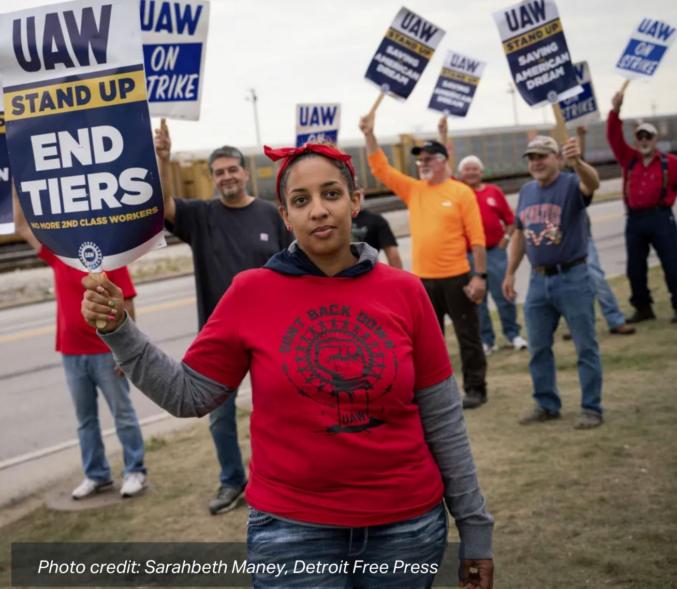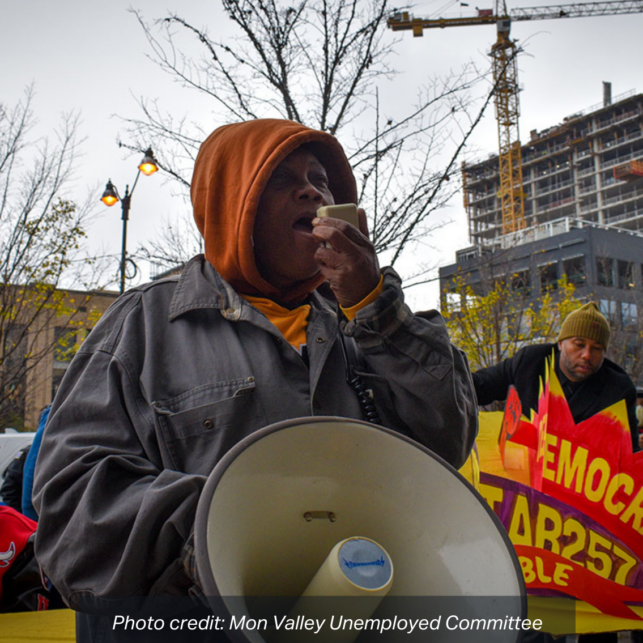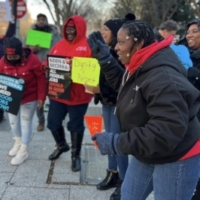Desegregate the Job Market
In a good-jobs economy, race, gender, immigration, or justice-involved status doesn’t determine workers’ fate.

What Is Occupational Segregation?
Occupational segregation is the systemic overrepresentation or underrepresentation of a demographic group in a particular occupation or field of employment.
In the U.S., Black and Latinx workers are overrepresented in dangerous jobs, underpaying jobs, and jobs with few benefits. Black women workers, immigrants, and people with records face particularly high barriers to good jobs and economic security. A segregated labor market holds all workers back.
Occupational segregation was created by policy—an unequal labor market rooted in a history of slavery and segregation, exploitative immigration laws, and sexist assumptions about women’s roles. Factors such as discrimination, societal norms, economic forces, and education compound and reinforce it.
Desegregating Opportunity to Build a Good-Jobs Economy
A worker’s race, ethnicity, gender, or arrest/conviction record should not determine their job opportunities. Yet occupational segregation maintains the structural racism built into a labor market founded on enslaved labor.
The antidote to occupational segregation is building worker power and a good-jobs economy.
Read our full report for a closer look at occupational segregation in the pre-pandemic labor market of 2019, the mechanisms that reinforce it, and the history of occupational segregation, including how key policy choices made a difference.
For a look at occupational segregation that centers the experiences, perspective, and analysis of Black women, see NELP’s report, Purpose & Resistance: Black Women Workers Confronting Occupational Segregation.
The Impact of Occupational Segregation
Occupational segregation shapes workers’ ability to make a living, and influences everything from hiring and firing practices, to the impact of minimum wage laws, to access to unemployment benefits.
As a result of occupational segregation, workers of color:
- Face higher unemployment rates.
- Receive less support from unemployment insurance.
- Are over-represented in dangerous jobs, underpaying jobs, and jobs with few benefits.
- Are more likely to experience workplace violations such as wage theft.
- Are more likely to be employed by temp agencies or by gig companies where workplace protections are more limited or nonexistent.
In nearly every case, women of color disproportionately face the worst work situations.

Connecting Occupational Segregation to Racist Exemptions in FLSA
Frances Holmes is a food worker in St. Louis, Missouri. She and her coworkers are shifting the narrative to show wages are based on a system that has nothing to do with how hard you work or the hours you put in. Her blog breaks down why ending racist exemptions in the Fair Labor Standards Act rooted in segregation remains a critical policy goal.
Reversing Labor Laws Rooted in Slavery
Occupational segregation was created by policy: The unequal labor market is rooted in a history of slavery and Jim Crow segregation, as well as exploitative immigration laws and sexist assumptions about acceptable roles for women that contribute to the devaluation of women’s labor.
For example, as recently as 1963, it was entirely legal to discriminate on the basis of race and gender in hiring, and to pay women and workers of color less than men and white workers for the same work.
That’s why we believe ending the tipped minimum wage and the policy of at-will employment is integral to building a good-jobs economy for all workers. These racist policies are both results of employer backlash to Black emancipation from slavery in the U.S.
Policy Solutions to Uproot Occupational Segregation
Workers are organizing to win policies that remove structural barriers to mobility, so that all workers have the opportunity to move into good jobs and thrive.
Policies must ensure that every job pays a living wage, offers robust benefits, and enables workers to have a say in shaping the rules they work under.
Read our full report or our shorter executive summary for a closer look at policy solutions, as well as an analysis of the pre-pandemic labor market of 2019 and the history of occupational segregation.
We urge federal, state, and local policymakers to advance these policies:
- Adequately fund the Equal Employment Opportunity Commission (EEOC), the Office of Federal Contractor Compliance Programs, and state and local fair employment practices agencies.
- Mandate that employers pay workers the same pay for the same work.
- Prohibit companies from paying workers differently based on gender, race, or ethnicity when they perform substantially the same work; mandate pay transparency; and ban employers from asking about salary history.
- Revisit the use of audit testing (also known as matched-pair testing) by federal, state, and local fair employment practices agencies to identify hiring discrimination, promote employment opportunities, and advance racial equity. See NELP’s publication on audit testing.
- Curtail the use of arrest and conviction records and personal credit histories in hiring, firing, and promotions. See NELP’s work on fair chance hiring and employment.
- Prevent discrimination based on justice-involved status and ensure pathways for people with records to enter licensed professions. See NELP’s work on fair chance licensing.
- Expand fundamental worker protections, including the Fair Labor Standards Act and Occupational Health and Safety Act, to include incarcerated workers and workers re-entering communities. See NELP’s work on building power for criminalized workers.
- Ensure immigrant workers benefit from full worker protections and are shielded from retaliation. See NELP’s work on immigrant workers.
FAQ: Occupational Segregation
Related Research
Related News
Trump Fires EEOC Commissioners Burrows and Samuels in Another Outrageous Attack on Civil Rights and Rule of Law

News Release
Trump Abandons Six Decades of Progress on Workplace Discrimination Protections for Federal Contractors

News Release
Celebrating Strength and Resistance: The Black Women Workers Roundtable

Blog



